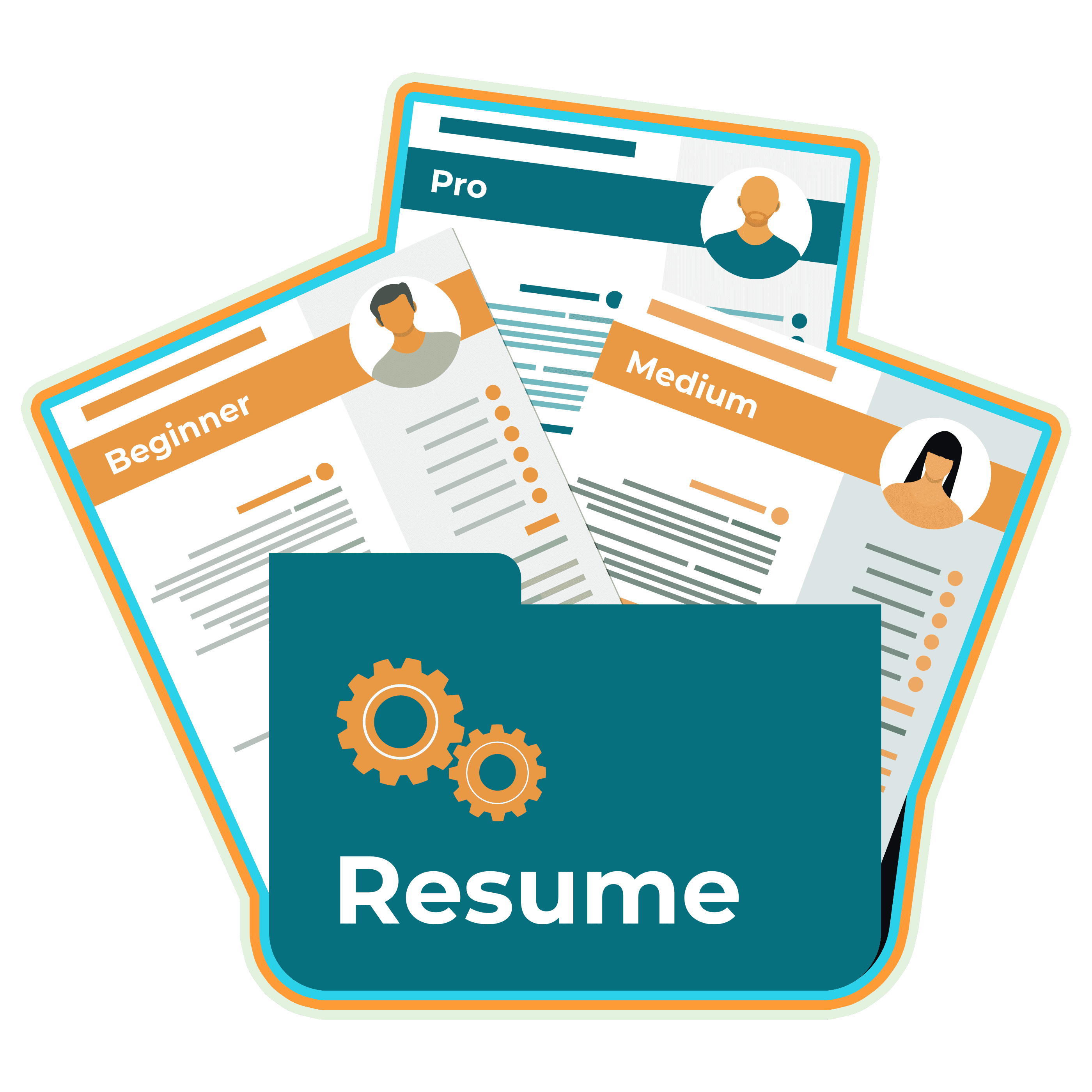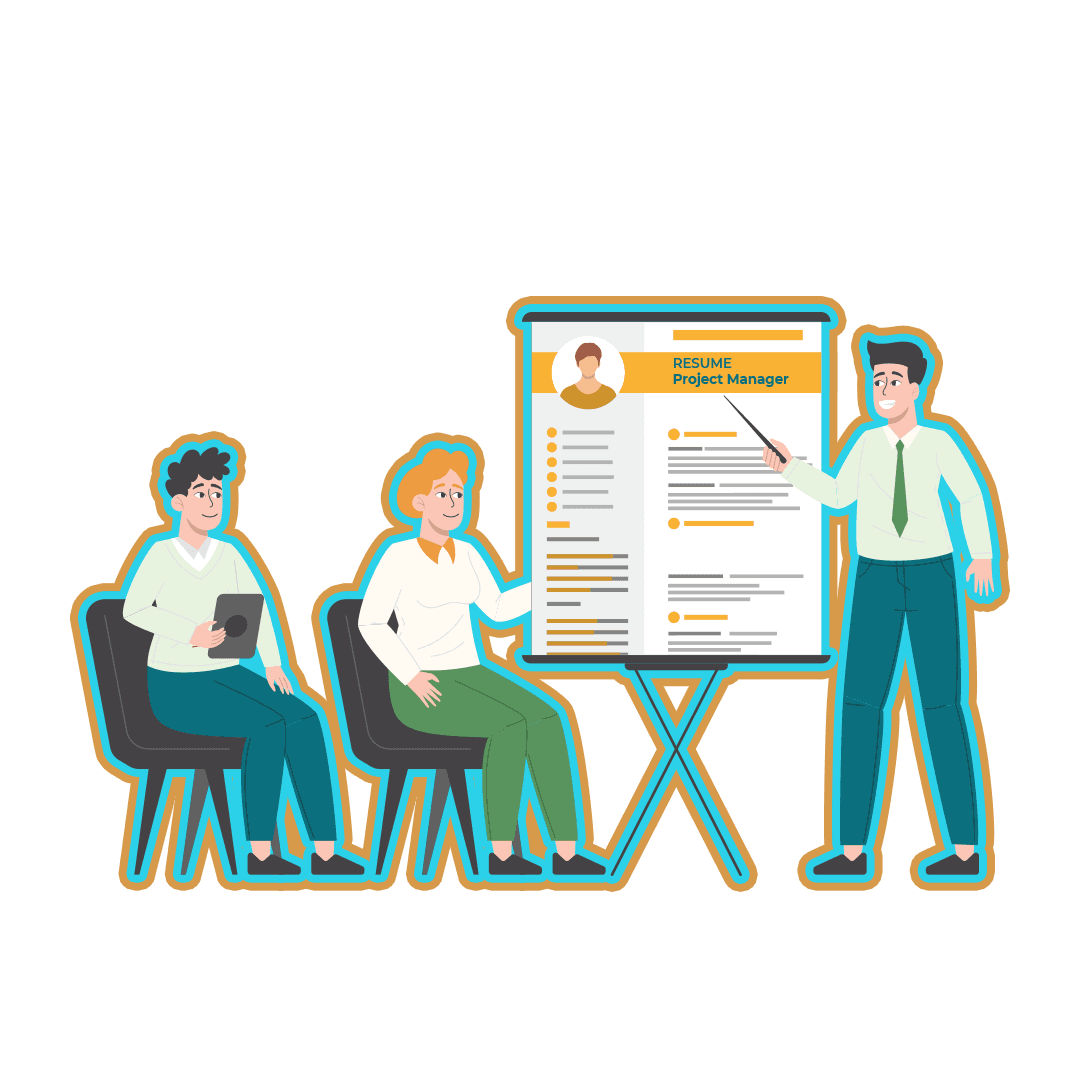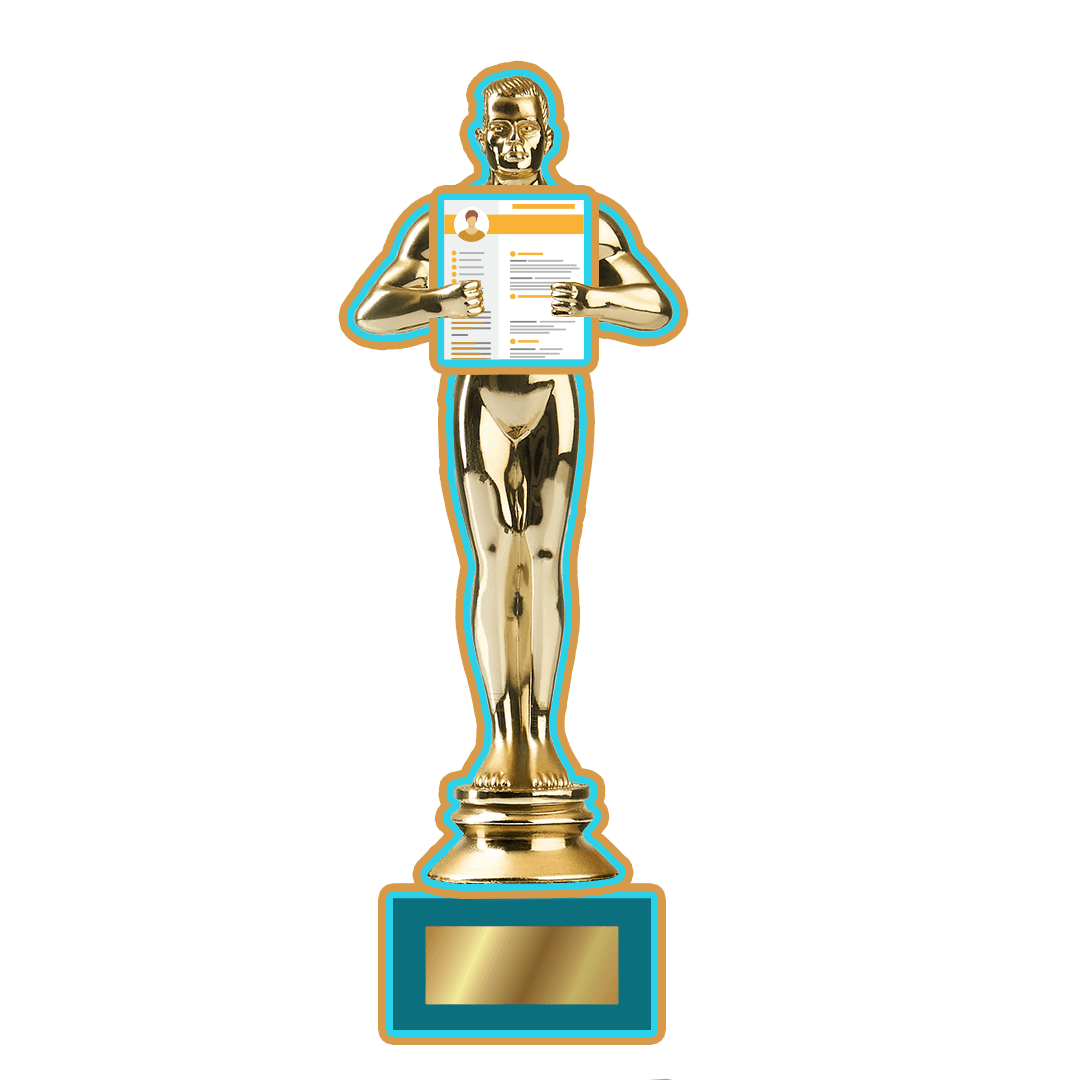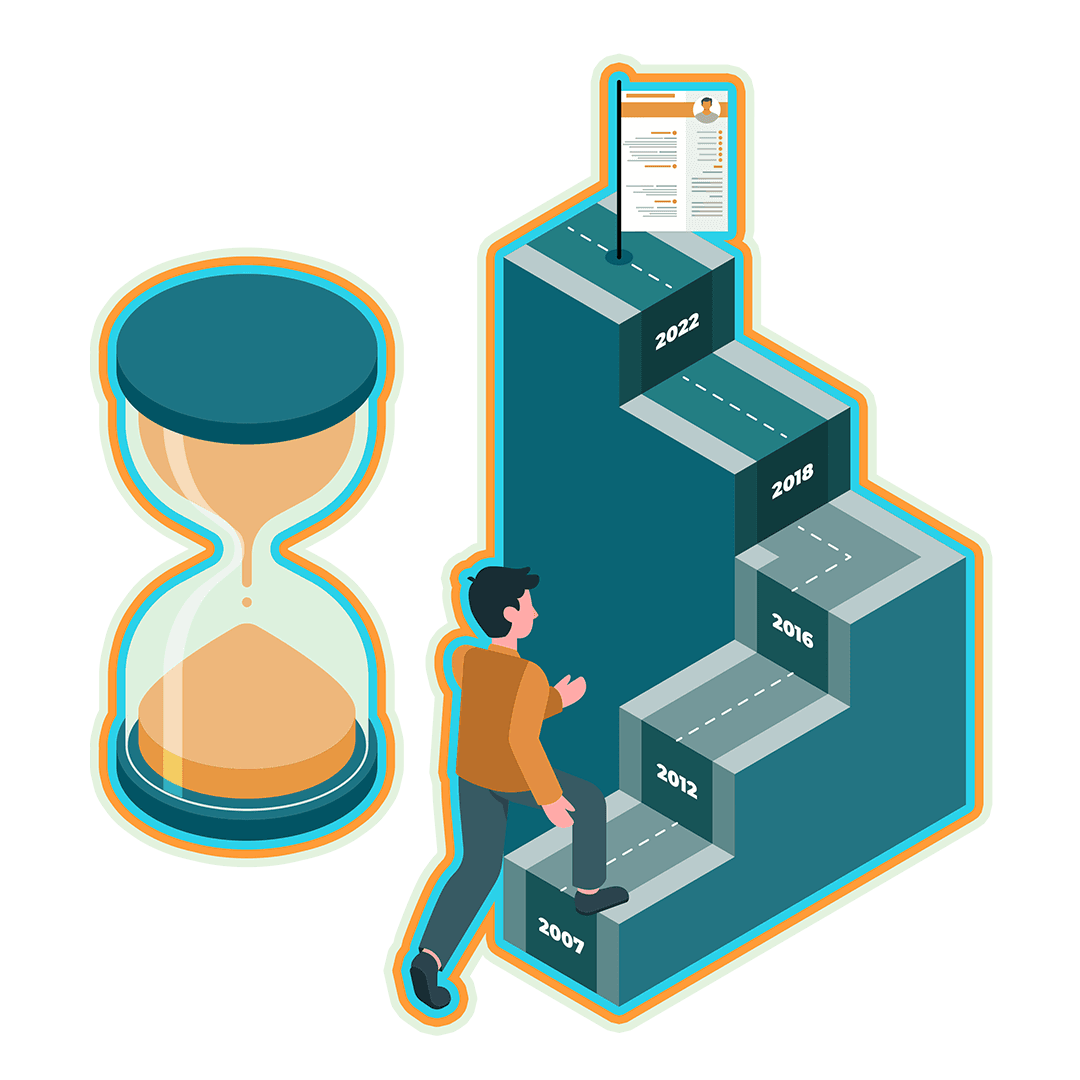Table of Contents
- How To Write Work Experience In Resume in 5 Steps
- How Much Work Experience To Include On Resume
- How To Include Work Experience In Resume
- How to Write a Resume With No Job Experience
- How To Put Current Job On Resume
- How To Explain Short-Term Employment On A Resume
- Can You Put Volunteer Work Under Work Experience
- How To Explain Gaps In Work On Resume
- Relevant Work Experience On Resume
- What To Put In Job Description On Resume
- Real-Life Work Experience Examples for 10 Fields
Crafting a captivating work experience section in the resume is crucial for showcasing the professional journey and reaching potential employers. Present concise yet compelling summaries of roles, responsibilities, and achievements to demonstrate skills, drive, and value. Make an impact with a well-crafted work experience section highlighting accomplishments and illustrating future success potential.
The resume's work experience section must be carefully crafted to highlight professional development and catch the attention of hiring managers. Determining how much work experience to include on a resume is a critical aspect of crafting a practical job application. To create an effective resume, it is essential to present the work history in a clear and organized manner.
Explaining gaps in the work history is essential to crafting a resume that effectively addresses employment lapses. You can put volunteer work under the "Work Experience" section of the resume, especially if it is relevant to the job objective. Having relevant work experience on a resume is essential in showcasing skills, expertise, and suitability for a specific role.
Job description on a resume plays a crucial role in showcasing skills, experiences, and qualifications to potential employers. The work experience section is essential for highlighting the background in the field and proving qualifications to potential employers.
How To Write Work Experience In Resume in 5 Steps
The resume's work experience section must be carefully crafted to highlight professional development and catch the attention of hiring managers. Use these five steps to highlight professional experience effectively.
- Start with a powerful summary. Begin the work experience section with a concise overview of the career trajectory, highlighting key accomplishments and skills. Titles and organizations worked for should be listed. Mention the duration of employment and any promotions or significant milestones achieved. Ensure that the summary showcases expertise and aligns with the specific job or industry targeted, capturing the essence of the professional background.
- Tailor descriptions to each role. Describe the responsibilities and achievements of each position, emphasizing the impact of that position. Demonstrate contributions with action verbs and specific, quantifiable results. Highlight relevant skills, knowledge, and achievements that align with the job requirements. Demonstrate capabilities to handle complex tasks and deliver exceptional results. Communicate achievements and how they have positively impacted the organization with engaging language.
- Focus on measurable accomplishments. Showcase specific skills and accomplishments that demonstrate value to employers. Quantify achievements whenever possible (e.g., "Increase sales by 30%," "Manage a team of 15 employees," "Implement cost-saving measures resulting in $100,000 annual savings"). Awards, recognition, and notable achievements should be included. Clearly articulate the challenges faced, the actions taken, and the measurable outcomes achieved. Use concrete examples to illustrate the impact and provide context for achievements.
- Highlight relevant experiences. Simplify the work experience section by emphasizing the experiences most relevant to the job. Prioritize experiences that directly relate to the desired position or industry. Include internships, volunteer work, or freelance projects that showcase relevant skills and experiences. Explain how previous experiences have equipped with the necessary skills and knowledge to excel in the target role. Emphasize transferable skills and demonstrate how diverse backgrounds have prepared for success.
- Use the proper format and structure. Organize the work experience section in a clean, easily scannable format, ensuring clarity and coherence. Use bullet points to present responsibilities and achievements. Arrange the experiences in reverse chronological order. Maintain consistency in formatting, font, and spacing throughout the resume. Craft a visually appealing resume layout highlighting the most critical information while maintaining a professional and organized appearance. Pay attention to font choice, bullet point consistency, and overall readability.
How Much Work Experience To Include On Resume
Determining how much work experience to include on a resume is a critical aspect of crafting a practical job application. It's essential to strike the right balance to showcase the professional background compellingly and concisely.
Tailoring a resume to the job requirements is crucial, allowing the candidate to highlight the most pertinent aspects of the professional history. The customization helps employers see the alignment between the candidate's experience and company needs. Focus on recent and significant roles that directly align with the job requirements. Including approximately 10 to 15 years of work experience is a good guideline, as this timeframe allows to highlight the most relevant and impactful positions. It helps keep a resume concise and targeted rather than overwhelming it with excessive detail.
Emphasize critical accomplishments and responsibilities that showcase qualifications for the desired role. Use action verbs and quantitative data to illustrate the impact of the work, making it easier for employers to understand contributions. To create a compelling and concise summary of the professional background, emphasize skills and achievements directly related to the job you're applying for. Ensure the resume highlights qualifications effectively, leaving a lasting impression on potential employers. The goal is to demonstrate how experience makes the candidate an ideal fit for the position.
Do You Have To Include All Past Jobs On Resume?
No, you don't have to include all past jobs on a resume. It is expected to wonder if all the employment history needs to be included. However, the answer to this question depends on various factors and considerations. In general, it is not necessary to include all past jobs on a resume, especially if they are not relevant to the position applying for or if you have a long work history. Instead, it is more important to highlight the most relevant and significant experiences and the skills and qualifications for the desired job. Potential employers are more impressed with the resume if it is tailored to the job application.
How To Include Work Experience In Resume
To create an effective resume, it is essential to present the work history in a clear and organized manner. The work experience section guides you through showcasing the professional background to grab the attention of potential employers. Listed below are some critical steps to consider.
1. Start with a Professional Summary. Begin the resume with a professional summary highlighting the experience, key skills, and career achievements. The concise statement serves as an introduction and sets the tone for the rest of the resume. It has to capture the attention of hiring managers and make them eager to delve deeper into the work history.
2. Use a Reverse Chronological Format. The most common and preferred format for presenting work experience is in reverse chronological order. It means listing the most recent or current job first and then working backward in time. The chronological format lets employers see the recent accomplishments and gauge the career progression.
3. Provide Clear Job Descriptions. Provide a concise job description highlighting responsibilities, tasks, and accomplishments for each position listed. Use action verbs and quantifiable achievements to demonstrate the impact in previous roles. It helps employers understand the specific contributions and the value the applicant is able to bring to the organization.
4. Focus on Relevant Experience. Tailor the work experience section to emphasize the roles and responsibilities that are most relevant to the position. Prioritize showcasing skills and accomplishments that align with the requirements of the desired position. The targeted approach demonstrates the candidate's suitability for the role and increases its chances of being shortlisted for an interview.
5. Include Metrics and Results. Include measurable metrics and results to prove achievements. Quantify accomplishments by mentioning specific numbers, percentages, or other relevant indicators. It adds credibility to the resume and helps employers gauge the impact of the previous work.
6. Incorporate Keywords. Include relevant keywords throughout the work experience section to optimize the resume for electronic applicant tracking systems (ATS). The keywords must align with the job description and industry-specific terminology, increasing the chances of the resume getting noticed.
7. Highlight Promotions and Advancements. Highlight promotions and significant advancements in previous positions to showcase the growth within organizations and demonstrate the ability to excel and take on additional responsibilities in the career.
Show Promotion On Resume
It's crucial to mention advancement in the resume succinctly. Here's how to correctly highlight promotions in a CV.
- Position the promotion prominently. Place the promotion information in a visible location on the resume, such as under the employment section or in a separate "Promotions" section. It ensures that the reader can quickly identify advancement within the company.
- Include the job titles. Clearly state both initial and promoted positions. For example, list the positions as "Junior Sales Associate (2017-2019)" and "Senior Sales Associate (2019-present)".
- Provide a brief description. Describe responsibilities and achievements in each position. Focus on the skills and accomplishments relevant to the job. Use bullet points to make it easy to read and emphasize the key points.
- Highlight the promotion. Use formatting techniques such as bolding, italicizing, or underlining to make the promotion stand out. Include "Promoted" or "Promotion" next to the relevant job title to draw attention to advancement.
- Quantify the achievements. Quantify accomplishments to showcase the impact in both roles. Use numbers, percentages, or specific examples to demonstrate the contributions and results.
- Show progression. Illustrate additional promotions or advancements received within the company, if applicable, showcasing the continuous growth and development.
Accomplishments To Put On A Resume
The resume serves as a crucial tool to make a solid first impression on potential employers, and one of the most effective ways to stand out is by highlighting the accomplishments. Candidate's achievements demonstrate the ability to deliver results, contribute value, and make a tangible impact. Here are some key accomplishments to consider, including in a resume, which help the applicants grab the attention of hiring managers and increase the chances of landing the desired job.
- Sales: Consistently exceeded sales targets by 20% for three consecutive quarters.
- Leadership: Effectively led a cross-functional team, ensuring the successful completion of a project ahead of schedule.
- Cost-saving: Implemented an initiative that resulted in a 15% reduction in operational expenses.
- Customer Satisfaction: Maintained an impressive 95% customer satisfaction rating through exceptional service and problem-solving.
- Process Improvement: Streamlined workflows, leading to a notable 30% increase in overall efficiency.
- Awards: Recognized as "Employee of the Month" twice for outstanding performance.
- Professional Development: Completed advanced project management training to enhance skills and expertise.
- Public Speaking: Delivered engaging presentations at industry conferences, showcasing effective communication skills.
- Community Involvement: Actively volunteered for local community initiatives, making a positive impact.
- Academic Achievements: Graduated with honors in Business Administration, demonstrating academic excellence.
How to Write a Resume With No Job Experience
Entering the job market without previous work experience is challenging, but it doesn't mean the resume lacks substance. A resume is able to be compelling if it emphasizes skills, achievements, and relevant experiences.
To write a resume with no job experience, follow the provided tips.
Education and Academic Achievements: Emphasize the educational background, including relevant coursework, projects, and academic accomplishments. For example:
Bachelor of Science in Computer Science, Stanford University (Expected Graduation: May 2023)
- Project: Developed a mobile application for a local charity organization, improving its donation tracking system.
Extracurricular Activities and Leadership Roles: Highlight the involvement in extracurricular activities, clubs, or organizations, demonstrating transferable skills such as teamwork, leadership, and communication. For instance:
President, Stanford University Debate Club (2019-2020)
- Organized and led weekly debate sessions, fostering critical thinking and public speaking skills among members.
- Coordinated a regional debate competition with over 20 participating universities, managing logistics and ensuring a smooth event.
Internships, Volunteering, and Freelance Work: Include any internships, volunteer work, or freelance projects completed, as the projects provide valuable experience and showcase the skills. For example:
Social Media Marketing Intern, Maxxima Company (Summer 2022)
- Assisted in developing and implementing marketing campaigns, contributing to a 10% boost in online sales.
Relevant Skills and Certifications: List any relevant skills or certifications, such as computer programming languages, software proficiency, or industry-specific certifications. For instance:
Technical Skills: Proficient in HTML/CSS, Python, Adobe Photoshop
Certifications: Google Analytics Certified, Microsoft Office Specialist (Excel)
Projects and Personal Initiatives: Showcase any personal projects or initiatives you have undertaken that demonstrate the passion, dedication, and ability to take the initiative. For example:
Created and managed a personal blog focused on environmental sustainability, attracting over 5,000 monthly readers and collaborating with industry experts for guest posts.
How To Put Current Job On Resume
It's essential to provide clear, concise information that showcases the current role and responsibilities. Here's a step-by-step guide to effectively presenting the current job on the resume.
Job Title and Company: Begin by stating the current job title and the name of the company or organization you work for. The information is able to be prominently displayed at the top of the resume, either as a heading or in a dedicated section.
Example:
Current Job Title: Marketing Manager
Company: Microsoft Corporation
Dates of Employment: Indicate the duration of the current employment by mentioning the start date and using "Present" or "Current" as the end date. Example:
Employment Dates: January 2018 - Present
Key Responsibilities: Outline the primary job responsibilities and duties in bullet-point format. Focus on the most relevant tasks to the job that is being applied for and emphasize the achievements and contributions. Example:
- Develop and execute comprehensive marketing strategies to drive brand awareness and increase customer acquisition.
- Manage a team of five marketing professionals, providing guidance and support in achieving departmental objectives.
- Oversee the creation and implementation of digital marketing campaigns, resulting in a 20% increase in online sales.
Achievements and Impact: Highlight any notable accomplishments or successes gained in the current role. It includes exceeding targets, implementing process improvements, receiving recognition or awards, or contributing to the company's growth or profitability. Example:
- Led a successful product launch campaign, resulting in a 30% increase in product sales within the first quarter.
- Developed and implemented a customer retention program, reducing churn rate by 15% and increasing customer satisfaction.
Professional Development: Mention relevant professional development activities or certifications, if applicable, showcasing the commitment to continuous learning and growth. Example:
- Completed a certification course in project management, enhancing skills in planning, execution, and team coordination.
How To Explain Short-Term Employment On A Resume
Short-term employment experiences sometimes raise questions for potential employers, but with the right approach, short-term employments are able to be explained effectively. Here are some tips and strategies to address short-term employment and present it in a positive light.
- Include Relevant Short-Term Positions: Include a short-term job in the work experience section if relevant to the position. Emphasize the skills, responsibilities, and achievements acquired during that period.
- Provide a Clear Explanation: Use a brief statement or bullet point to explain the reason for short-term employment, such as contract work, seasonal employment, or temporary assignments. Be honest and concise in the explanation.
- Focus on Achievements: Emphasize significant accomplishments or contributions during the short-term employment. It demonstrates the ability to impact quickly and effectively, regardless of the duration.
- Showcase Transferable Skills: Highlight the skill or strengthen during the short-term employment relevant to the position. It helps recruiters see the value the candidates are able to bring to their organization.
- Emphasize Adaptability and Fast Learning: Emphasize adaptability, quick learning, and the ability to thrive in diverse work settings if you have multiple short-term roles. Highlighting these qualities showcases versatility and eagerness to tackle new challenges.
- Use a Functional Resume Format: Consider utilizing a functional resume format if the short-term employment experiences are unrelated to the desired position or industry. This format prioritizes skills and achievements over a chronological work history.
- Address the Gap in Employment: Highlight how you maximized time during any gaps between short-term roles by enhancing skills, pursuing professional development, engaging in relevant freelance work, or volunteering.
- Be Prepared for Interview Questions: Interviewers may inquire about short-term employment experiences. Practice explaining the reasons behind the short-term roles confidently and positively to address any concerns they may have.
Can You Put Volunteer Work Under Work Experience
You can put volunteer work under the "Work Experience" section of the resume, especially if it is relevant to the job objective. Traditional work experience typically refers to paid employment, but volunteering demonstrates valuable skills and qualities employers seek. Here's an expansion of the given information with examples.
Volunteer Coordinator, American Red Cross Nonprofit Organization, Chicago, Illinois
Developed and implemented volunteer training programs, ensuring effective onboarding and engagement of new volunteers.
Social Media Manager, Volunteer Role, Los Angeles, California
- Created and executed social media campaigns, increasing the organization's online presence and engagement by 30%.
- Managed content creation and scheduling for various social media platforms, effectively reaching a wider audience and promoting the organization's mission.
Highlight the skills and accomplishments gained through the volunteer work by providing specific details about the volunteer experience, such as the organization volunteered for, the role, and achievements or responsibilities. Remember to tailor the volunteer experience to align with the job requirements, emphasizing the transferable skills and relevant experiences that make you a strong candidate.
Including volunteer work in a resume demonstrates dedication, initiative, and commitment to making a positive impact, ultimately strengthening the overall candidacy for employment opportunities.
How To Explain Gaps In Work On Resume
Explaining gaps in the work history is essential to crafting a resume that effectively addresses employment lapses. Employers often seek clarification on these gaps to understand the career progression and assess the candidate's suitability for a role. Here's a comprehensive guide to explaining gaps in work on the resume, along with examples to help job seekers present the situation positively and confidently.
1. Be Honest and Transparent: Honesty is crucial when addressing gaps in the work history. Clearly state the reasons for the gaps, whether it was due to personal reasons, health issues, career transition, or pursuing further education. Avoid providing misleading information or covering up the gaps, as it may raise concerns during the hiring process.
Example:
"Took a sabbatical to care for a family member with a serious medical condition, providing full-time support and ensuring their well-being during a critical period."
2. Emphasize Transferable Skills and Experiences: The gap year is likely to have provided you with valuable skills or relevant experiences. Highlight any freelance work, volunteer activities, consulting projects, or courses completed. It demonstrates the commitment to continuous learning and development and the ability to adapt and apply the skills in different settings.
Example:
"Engaged in freelance web design projects, building a portfolio of clients and honing my skills in HTML, CSS, and UX/UI design during a career transition phase."
3. Address Career Development Activities: Highlighting certifications, workshops, or training programs completed during a gap period demonstrates a commitment to self-improvement and professional growth, reinforcing the commitment to advancing qualifications even while unemployed.
Example:
"Enrolled in an intensive digital marketing certification program, gaining expertise in SEO, content marketing, and social media strategy to stay updated with industry trends."
4. Explain Entrepreneurial Endeavors: Emphasize skills and experiences gained from self-employment or starting your own business during the gap. Highlight achievements like revenue generation, client acquisition, and innovative solutions.
Example:
"Launched a successful online boutique, managing all aspects of the business, including sourcing products, marketing, and customer service, resulting in a steady stream of loyal customers and consistent sales growth."
5. Showcase Relevant Personal Projects: Mention personal projects or independent skill development to showcase motivation and commitment to professional growth.
Example:
"Dedicated time to create a personal finance blog, producing well-researched articles on budgeting, investing, and financial planning, attracting a large readership and positive feedback."
Relevant Work Experience On Resume
Having relevant work experience on a resume is essential in showcasing skills, expertise, and suitability for a specific role. The section provides hiring managers with a clear understanding of the professional background and demonstrates the ability to perform in the desired position. Including specific details and examples will further strengthen the resume. Here are some key elements to consider when highlighting the relevant work experience.
1. Job Title and Company: State job titles and the names of the companies you worked for.
Marketing Specialist, Microsoft Corporation Project Manager, Boston Consulting Group
2. Job Responsibilities: Describe primary responsibilities and duties in each role. Use action verbs and specific details to demonstrate contributions. For example:
- Managed end-to-end marketing campaigns, including market research, content creation, and digital advertising, resulting in a 20% increase in customer engagement.
- Led a team of five project coordinators, overseeing project planning, resource allocation, and budget management, completing 10 complex projects within deadline and budget constraints.
3. Achievements and Impact: Highlight any notable achievements or accomplishments during tenure. Quantify results whenever possible to provide tangible evidence of contributions. For example:
- Developed and implemented a customer retention program, resulting in a 15% increase in customer retention within six months.
- Streamlined inventory management processes, reducing costs by 10% and improving order fulfillment time by 20%.
4. Relevant Skills: Identify and highlight the skills gained and utilized in each position appropriate to the desired role. This could include technical skills, soft skills, or industry-specific knowledge. For example:
- Proficient in data analysis using Excel, Google Analytics, and Tableau tools.
- Demonstrated strong communication and leadership skills through cross-functional collaboration and team management.
5. Duration of Employment: Specify the duration of the employment for each position, including the month and year started and finished. For example:
January 2018 - July 2020August 2015 - Present
Should You Put Non-Relevant Work Experience On A Resume
No, you should not put non-relevant work experience on a resume. Including non-relevant work experience on a resume is unnecessary.
Having non-relevant work experience on a resume has both advantages and disadvantages. Non-relevant work demonstrates the work history, commitment, and diverse skill set. It showcases transferable skills like communication, teamwork, and problem-solving abilities. On the other hand, too much non-relevant experience clutter the resume and distracts from the most relevant qualifications.
The decision must be based on the specific job you're applying for, the level of relevance of the non-relevant experience, and the space limitations of the resume. Carefully assess how each experience contributes to candidacy, emphasizing the most applicable and impactful achievements. Tailoring the resume to highlight the most relevant experiences will help ensure that the application aligns closely with the job requirements and captures the attention of potential employers.
What To Put In Job Description On Resume
Job description on a resume plays a crucial role in showcasing skills, experiences, and qualifications to potential employers. Here are some specific elements to include in this section to effectively highlight suitability for the position:
1. Job Title and Company: State job titles and the name of the companies or organizations worked for. For example:
Marketing Manager, The Coca-Cola CompanySoftware Developer, Exxon Mobil Corporation
2. Key Responsibilities: Outline main responsibilities and tasks in bullet points or concise sentences. Be specific and highlight relevant achievements. For instance:
- Led a team of five marketing professionals to develop and implement strategic marketing campaigns, resulting in a 25% increase in lead generation within six months.
- Developed and maintained responsive web applications using JavaScript, HTML, and CSS, ensuring seamless user experiences and high-quality performance.
3. Achievements and Results: Include quantifiable achievements and outcomes to demonstrate the impact of the work. Use specific numbers, percentages, or metrics whenever possible. Examples include:
- Successfully managed a $1 million budget, consistently delivering projects within budget and achieving a 15% cost reduction through streamlined procurement processes.
- Increased customer satisfaction ratings by 20% by implementing improved customer service strategies and staff training programs.
4. Skills and Expertise: Highlight relevant skills, technical proficiencies, and industry knowledge that align with the job requirements. Be sure to include both hard and soft skills. For example:
- Proficient in Adobe Photoshop, Illustrator, and InDesign for graphic design and visual content creation.
- Strong interpersonal and communication skills, demonstrated through effective collaboration with cross-functional teams and client relationship management.
5. Certifications and Training: Mention any relevant certifications, professional development courses, or training programs completed. This demonstrates the commitment to continuous learning and expertise in specific areas. For instance:
- Certified Scrum Master (CSM) with comprehensive knowledge of agile methodologies and successful implementation of Scrum practices in previous projects.
- Completed Google Ads Certification, demonstrating proficiency in managing and optimizing digital advertising campaigns.
How to Describe Your Work Experience in a Resume
The work experience section is essential for highlighting the background in the field and proving qualifications to potential employers. When summarizing the employment background in a CV, including precise particulars and emphasizing critical abilities and accomplishments is crucial. Below are some suggestions for effectively portraying the work experience.
- Start with a Strong Summary: Summarize the overall work experience, highlight the most relevant skills, and briefly mention accomplishments.
- Use Action Verbs: Begin each bullet point with strong action verbs to emphasize responsibilities and achievements. For example, "Managed," "Implemented," "Achieved," or "Collaborated."
- Quantify Achievements: Provide quantifiable results whenever possible to demonstrate the impact of the work. For instance, mention specific percentages, dollar amounts, or metrics showing contributions.
- Highlight Relevant Skills: Focus on the skills and competencies that are most relevant to the job you're applying for. Tailor descriptions to align with the desired qualifications outlined in the job description.
- Show Career Progression: Demonstrate growth and development within previous roles by highlighting promotions, increased responsibilities, or successful projects led, if applicable.
- Include Relevant Projects: Highlight notable projects or initiatives to demonstrate the ability to handle complexity and achieve successful outcomes.
- Showcase Teamwork and Collaboration: Highlight instances where you collaborated with colleagues or teams to achieve objectives, emphasizing the ability to work effectively in a team environment.
- Focus on Results: Don't just list the responsibilities, but emphasize the achievements. Employers are interested in seeing how the work positively impacts the organization.
- Customize for Each Job Application: Tailor the work experience descriptions to match the specific requirements and qualifications of each job you apply for. Highlight the skills and achievements most relevant to the position.
- Keep it Concise and Readable: Use bullet points and concise sentences to make the work experience section easy to read and scan. Avoid using excessive jargon or acronyms that may not be familiar to all readers.
Real-Life Work Experience Examples for 10 Fields
Gaining real-life work experience is invaluable for professional development. Here are ten compelling examples of work experience across diverse fields, providing a glimpse into the practical applications of skills and expertise in various industries.
1. Software Engineer ( Technology/IT)
2. Marketing Manager (Marketing/Advertising)
3. Registered Nurse (Healthcare/Medical)
4. Financial Analyst (Finance/Investment)
5. Graphic Designer (Design/Creative)
6. Sales Representative (Sales/Business Development)
7. Human Resources Coordinator (Human Resources)
8. Project Manager (Project Management)
9. Environmental Scientist (Environmental/Science)
10. Customer Service Representative (Customer Service)
The "Right" examples in each job position highlight specific accomplishments, responsibilities, and achievements that demonstrate the candidate's expertise and impact. On the other hand, the "Wrong" examples showcase more basic or minimal tasks that do not fully reflect the candidate's capabilities or contributions. These comparisons provide a realistic understanding of what distinguishes strong work experience descriptions from weaker ones within each field.




